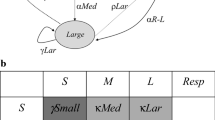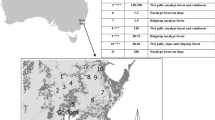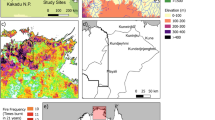Abstract
Woody plant demographics provide important insight into ecosystem state-shifts in response to changing fire regimes. In Australian tropical savannas, the switch from patchy landscape burning by Aborigines to unmanaged wildfires within the past century has been implicated in biodiversity declines including the fire-sensitive conifer, Callitris intratropica. C. intratropica commonly forms small, closed-canopy groves that exclude fire and allow recruitment of conspecifics and other fire-sensitive woody plants. C. intratropica groves provide a useful indicator of heterogeneity and fire regime change, but the mechanisms driving the species’ persistence and decline remain poorly understood. We examined the hypothesis that C. intratropica population stability depends upon a regime of frequent, low-intensity fires maintained by Aboriginal management. We combined integral projection models of C. intratropica population behaviour with an environmental state change matrix to examine how vital rates, grove dynamics and the frequency of high- and low-intensity fires contribute to population stability. Closed-canopy C. intratropica groves contributed disproportionately to population growth by promoting recruitment, whereas singleton trees accounted for a larger proportion of adult mortality. Our patch-based population model predicted population declines under current fire frequencies and that the recruitment of new groves plays a critical role in the species’ persistence. Our results also indicated that reducing fire intensity, a key outcome of Aboriginal burning, leads to C. intratropica population persistence even at high fire frequencies. These findings provide insight into the relationship between ecosystem composition and human–fire interactions and the role of fire management in sustaining the mosaics that comprise ‘natural’ systems.






Similar content being viewed by others
References
Anderson DR, Burnham KP. 2002. Avoiding pitfalls when using information-theoretic methods. J Wildl Manag 66:912–18.
Archibald S, Roy DP, van Wilgen BW, Scholes RJ. 2009. What limits fire? An examination of drivers of burnt area in Southern Africa. Glob Change Biol 15:613–30.
Bessie W, Johnson E. 1995. The relative importance of fuels and weather on fire behavior in subalpine forests. Ecology 76:747–62. http://www.esajournals.org/doi/abs/10.2307/1939341. Last accessed 02/11/2013.
Bilbao BA, Leal AV, Mendez CL. 2010. Indigenous use of fire and forest loss in Canaima National Park, Venezuela. Assessment of and tools for alternative strategies of fire management in Pemón indigenous lands. Human Ecol 38:663–73.
Bliege Bird R, Codding BF, Kauhanen PG, Bird DW. 2012. Aboriginal hunting buffers climate-driven fire-size variability in Australia’s spinifex grasslands. Proc Natl Acad Sci USA 109:10287–92. http://www.pubmedcentral.nih.gov/articlerender.fcgi?artid=3387077&tool=pmcentrez&rendertype=abstract. Last accessed 13 Feb 2013.
Bond WJ. 2008. What limits trees in C 4 grasslands and savannas? Ann Rev Ecol Evol Syst 39:641–59. http://www.annualreviews.org/doi/abs/10.1146/annurev.ecolsys.39.110707.173411. Last accessed 11 Feb 2013.
Bowman D, McDermott HJ, Nichols SC, Murphy BP. 2014. A grass–fire cycle eliminates an obligate-seeding tree in a tropical savanna. Ecol Evol 4:4185–94. http://onlinelibrary.wiley.com/doi/10.1002/ece3.1285/full. Last accessed 02 Mar 2015.
Bowman DMJS, Franklin DC, Price OF, Brook BW. 2007. Land management affects grass biomass in the Eucalyptus tetrodonta savannas of monsoonal Australia. Aust Ecol 32:446–52.
Bowman DMJS, Panton WJ. 1993. Decline of Callitris intratropica R. T. Baker & H. G. Smith in the Northern Territory: implications for pre- and post-European colonization fire regimes. J Biogeogr 20:373–81.
Bowman DMJS, Wilson BA, Davis GW. 1988. Response of Callitris intratropica R.T. Baker & H.G. Smith to fire protection, Murgenella, northern Australia. Aust J Ecol 13:147–59.
Caswell H, Kaye T. 2001. Stochastic demography and conservation of an endangered perennial plant (Lomatium bradshawii) in a dynamic fire regime. Adv Ecol Res 32:1–51. http://www.sciencedirect.com/science/article/pii/S006525040132010X. Last accessed 10 Feb 2013.
Caswell H. 2006. Matrix population models. Sunderland, MA: Sinauer Associates, Inc. http://onlinelibrary.wiley.com/doi/10.1002/9780470057339.vam006m/full. Last accessed 17 Feb 2013.
Easterling MR, Ellner SP, Dixon PM. 2000. Size-specific sensitivity: applying a new structured population model. Ecology 81:694–708.
Edwards AC, Russell-Smith J. 2009. Ecological thresholds and the status of fire-sensitive vegetation in western Arnhem Land, northern Australia: implications for management. Int J Wildland Fire 18:127–46.
Ellair D, Platt W. 2013. Fuel composition influences fire characteristics and understorey hardwoods in pine savanna. J Ecol 101:192–201. http://onlinelibrary.wiley.com/doi/10.1111/1365-2745.12008/full. Last accessed 26 Feb 2013.
Ellner SP, Rees M. 2006. Integral projection models for species with complex demography. Am Nat 167:410–28.
Elston D, Moss R, Boulinier T. 2001. Analysis of aggregation, a worked example: numbers of ticks on red grouse chicks. Parisitology 122:563–9. http://journals.cambridge.org/production/action/cjoGetFulltext?fulltextid=82702. Last accessed 21 Feb 2013.
Franklin DC, Whitehead PJ, Pardon G, Matthews J, McMahon P, McIntyre D. 2005. Geographic patterns and correlates of the decline of granivorous birds in northern Australia. In: Fire and savanna management, Darwin, Australia, July 2002. pp 399–408.
Freeland WJ, Winter JW, Raskin S. 1988. Australian rock-mammals: a phenomenon of the seasonally dry tropics. Biotropica 20:70–9.
Gill AM, Ryan PG, Moore PHR, Gibson M. 2000. Fire regimes of world heritage Kakadu National Park, Australia. Aust Ecol 25:616–25.
Goldammer J. 1990. Fire in the tropical biota. Berlin: Springer http://scholar.google.com/scholar?hl=en&q=coutinho+fire+1990&btnG=&as_sdt=1,5&as_sdtp=#1. Last accessed 11 Feb 2013.
Govender N, Trollope WSW, Van Wilgen BW. 2006. The effect of fire season, fire frequency, rainfall and management on fire intensity in savanna vegetation in South Africa. J Appl Ecol 43:748–58.
Guyette RP, Muzika RM, Dey DC. 2002. Dynamics of an anthropogenic fire regime. Ecosystems 5:472–86.
Hawkins P. 1966. Seed production and litter fall studies of Callitris columellaris. Aust For Res 2:3–16. http://scholar.google.com/scholar?hl=en&q=hawkins+callitris&btnG=&as_sdt=1,5&as_sdtp=#0. Last accessed 17 Feb 2013.
Heisler J, Briggs J, Knapp A, Blair J, Seery A. 2004. Direct and indirect effects of fire on shrub density and aboveground productivity in a mesic grassland. Ecology 85:2245–57. http://www.esajournals.org/doi/pdf/10.1890/03-0574. Last accessed 19 Feb 2013.
Hoffmann WA, Adasme R, Haridasan M, de Carvalho MT, Geiger EL, Pereira M a B, Gotsch SG, Franco AC. 2009. Tree topkill, not mortality, governs the dynamics of savanna-forest boundaries under frequent fire in central Brazil. Ecology 90:1326–37. http://www.ncbi.nlm.nih.gov/pubmed/19537552.
Hoffmann WA. 1999. Fire and population dynamics of woody plants in a neotropical savanna: matrix model projections. Ecology 80:1354–69.
Horvitz C, Schemske D. 1986. Seed dispersal and environmental heterogeneity in a neotropical herb: a model of population and patch dynamics. In: Estrada A, Fleming T, editors. Frugivores and seed dispersal. Rotterdam: Springer Netherlands. pp 169–86. http://www.bio.miami.edu/horvitz/bil235/brasil08/HORVITZCC_SCHEMSKEDW1986_OP.PDF. Last accessed 16 Feb 2013.
Keeley JE, Fotheringham CJ, Baer-Keeley M. 2006. Demographic patterns of postfire regeneration in Mediterranean-climate shrublands of California. Ecol Monogr 76:235–55.
Keeley JE. 2009. Fire intensity, fire severity and burn severity: a brief review and suggested usage. Int J Wildland Fire 18:116–26.
Knapp EE, Keeley JE. 2006. Heterogeneity in fire severity within early season and late season prescribed burns in a mixed-conifer forest. Int J Wildland Fire 15:37–45.
Laris P. 2002. Burning the seasonal mosaic: preventative burning strategies in the wooded savanna of southern Mali. Human Ecol 30:155–86.
Lawes M, Taplin P, Bellairs S, Franklin D. 2013. A trade-off in stand size effects in the reproductive biology of a declining tropical conifer Callitris intratropica. Plant Ecol 214:169–74. http://cat.inist.fr/?aModele=afficheN&cpsidt=26697698. Last accessed 17 Feb 2013.
Lawes MJ, Richards A, Dathe J, Midgley JJ. 2011. Bark thickness determines fire resistance of selected tree species from fire-prone tropical savanna in north Australia. Plant Ecol 212:2057–69. http://www.springerlink.com/index/10.1007/s11258-011-9954-7. Last accessed 12 Feb 2013.
Li C. 2002. Estimation of fire frequency and fire cycle: a computational perspective. Ecol Model 154:103–20.
Mandle L, Ticktin T, Zuidema P. 2015. Resilience of palm populations to disturbance is determined by interactive effects of fire, herbivory and harvest. J Ecol 103:1032–43.
Menges E. 2000. Population viability analyses in plants: challenges and opportunities. Trends Ecol Evol 15:51–6. http://www.sciencedirect.com/science/article/pii/S0169534799017632. Last accessed 17 Feb 2013.
Murphy B, Cochrane MA, Russell-Smith J. 2015. Prescribed burning protects endangered tropical heathlands of the Arnhem Plateau, northern Australia. J Appl Ecol . doi:10.1111/1365-2664.12455.
Murphy BP, Bowman DMJS. 2007. The interdependence of fire, grass, kangaroos and Australian Aborigines: a case study from central Arnhem Land, northern Australia. J Biogeogr 34:237–50.
Murphy BP, Bowman DMJS. 2012. What controls the distribution of tropical forest and savanna? Ecol Lett 15:748–58.
Nowacki GJ, Abrams MD. 2008. The demise of fire and “mesophication” of forests in the eastern United States. Bioscience 58:123–38.
Pascarella J, Horvitz C. 1998. Hurricane disturbance and the population dynamics of a tropical understory shrub: megamatrix elasticity analysis. Ecology 79:547–63. http://www.esajournals.org/doi/abs/10.1890/0012-9658(1998)079[0547:HDATPD]2.0.CO;2. Last accessed 13 Feb 2013.
Price O, Bowman DMJS. 1994. Fire-stick forestry: a matrix model in support of skilful fire management of Callitris intratropica R.T. Baker by north Australian Aborigines. J Biogeogr 21:573–80.
Prior LD, Bowman DMJS, Brook BW. 2007. Growth and survival of two north Australian relictual tree species, Allosyncarpia ternata (Myrtaceae) and Callitris intratropica (Cupressaceae). Ecol Res 22:228–36.
Prior LD, McCaw WL, Grierson PF, Murphy BP, Bowman DMJS. 2011. Population structures of the widespread Australian conifer Callitris columellaris are a bio-indicator of continental environmental change. For Ecol Manag 262:252–62.
Roques K. 2001. Dynamics of shrub encroachment in an African savanna: relative influences of fire, herbivory, rainfall and density dependence. J Appl Ecol 38:268–80. http://onlinelibrary.wiley.com/doi/10.1046/j.1365-2664.2001.00567.x/full. Last accessed 19 Feb 2013.
Russell-Smith J, Edwards A. 2006. Seasonality and fire severity in savanna landscapes of monsoonal northern Australia. Int J Wildland Fire 15:541–50. http://www.publish.csiro.au/?paper=WF05111. Last accessed 08 Mar 2013.
Russell-Smith J, Edwards AC, Price OF. 2012. Simplifying the savanna: the trajectory of fire-sensitive vegetation mosaics in northern Australia. J Biogeogr 39:1303–7.
Russell-Smith J. 2006. Recruitment dynamics of the long-lived obligate seeders Callitris intratropica (Cupressaceae) and Petraeomyrtus punicea (Myrtaceae). Aust Bot 54:479–85.
Stubben C, Milligan B. 2007. Estimating and analyzing demographic models using the popbio package in R. J Stat Softw 22:1–23. http://www.jstatsoft.org/v22/i11/paper. Last accessed 19 Feb 2013.
Trauernicht C, Brook BW, Murphy BP, Williamson GJ, Bowman DMJS. 2015. Local and global pyrogeographic evidence that indigenous fire management creates pyrodiversity. Ecol Evol 5:1908–18.
Trauernicht C, Murphy BP, Portner TE, Bowman DMJS. 2012. Tree cover–fire interactions promote the persistence of a fire-sensitive conifer in a highly flammable savanna. J Ecol 100:958–68.
Trauernicht C, Murphy BP, Tangalin N, Bowman DMJS. 2013. Cultural legacies, fire ecology, and environmental change in the Stone Country of Arnhem Land and Kakadu National Park, Australia. Ecol Evol 3:286–97.
Valverde T, Silvertown J. 1997. An integrated model of demography, patch dynamics and seed dispersal in a woodland herb, Primula vulgaris. Oikos 80:67–77.
Whitehead PJ, Bowman DMJS, Preece N, Fraser F, Cooke P. 2003. Customary use of fire by indigenous peoples in northern Australia: its contemporary role in savanna management. Int J Wildland Fire 12:415–25.
Van Wilgen BW, Govender N, Biggs HC, Ntsala D, Funda XN. 2004. Response of savanna fire regimes to changing fire management policies in a large African national park. Conserv Biol 18:1533–40.
Van Wilgen BW, Govender N, MacFadyen S. 2008. An assessment of the implementation and outcomes of recent changes to fire management in the Kruger National Park. Koedoe 50:22–31.
Woinarski JCZ, Armstrong M, Brennan K, Fisher A, Griffiths AD, Hill B, Milne DJ, Palmer C, Ward S, Watson M, Winderlich S, Young S. 2010. Monitoring indicates rapid and severe decline of native small mammals in Kakadu National Park, northern Australia. Wildl Res 37:116–26.
Woinarski JCZ, Hempel C, Cowie I, Brennan K, Kerrigan R, Leach G, Russell-Smith J. 2006. Distributional pattern of plant species endemic to the Northern Territory, Australia. Aust J Bot 54:627–40.
Wood SW, Murphy BP, Bowman D. 2011. Firescape ecology: how topography determines the contrasting distribution of fire and rain forest in the south-west of the Tasmanian Wilderness World Heritage Area. J Biogeogr 38:1807–20.
Yates C, Edwards A, Russell-Smith J. 2008. Big fires and their ecological impacts in Australian savannas: size and frequency matters. Int J Wildland Fire 17:768–81.
Yibarbuk D, Whitehead PJ, Russell-Smith J, Jackson D, Godjuwa C, Fisher A, Cooke P, Choquenot D, Bowman DMJS. 2001. Fire ecology and Aboriginal land management in central Arnhem Land, northern Australia: a tradition of ecosystem management. J Biogeogr 28:325–43.
Zuidema PA, Jongejans E, Chien PD, During HJ, Schieving F. 2010. Integral Projection Models for trees: a new parameterization method and a validation of model output. J Ecol 98:345–55.
Zuur A, Ieno E, Walker N, Saveliev A, Smith G. 2009. Mixed effects models and extensions in ecology with R. New York: Springer http://books.google.com/books?hl=en&lr=&id=vQUNprFZKHsC&oi=fnd&pg=PA1&dq=zuur+mixed+models&ots=kawEBQ2D4o&sig=7TqA_N3YpS1Ha-GIA7yNhaykERo. Last accessed 13 Feb 2013.
Acknowledgments
We are grateful to the Rostron family, Wesley Campion and the Djelk Aboriginal Ranger group for support and permission to work in Arnhem Land. These analyses would not have been possible without the initial guidance of Orou Gaoue and Carol Horvitz, made possible by a grant to CT from the National Climate Change Adaptation Research Facility of Australia, as well as the patient feedback of Lisa Mandle. Thanks to Talia Portner, Fay Johnston and Clancy Bowman for help in the field. Grants from the Commonwealth Environmental Research Facilities (CERF) Program of Australia, ANZ Holsworth Endowment, Australian Geographic, the Ecological Society of Australia and the Australian Research Council (LP110200006 and DE130100434) funded this research.
Author information
Authors and Affiliations
Corresponding author
Additional information
Author contributions
Clay Trauernicht performed research, analysed data, contributed new models and wrote the paper. Brett Murphy performed research and analysed data. Mike Lawes performed research and analysed data. Lynda Prior designed study and performed research. David Bowman conceived of study and performed research.
Electronic supplementary material
Below is the link to the electronic supplementary material.
Rights and permissions
About this article
Cite this article
Trauernicht, C., Murphy, B.P., Prior, L.D. et al. Human-Imposed, Fine-Grained Patch Burning Explains the Population Stability of a Fire-Sensitive Conifer in a Frequently Burnt Northern Australia Savanna. Ecosystems 19, 896–909 (2016). https://doi.org/10.1007/s10021-016-9973-2
Received:
Accepted:
Published:
Issue Date:
DOI: https://doi.org/10.1007/s10021-016-9973-2




